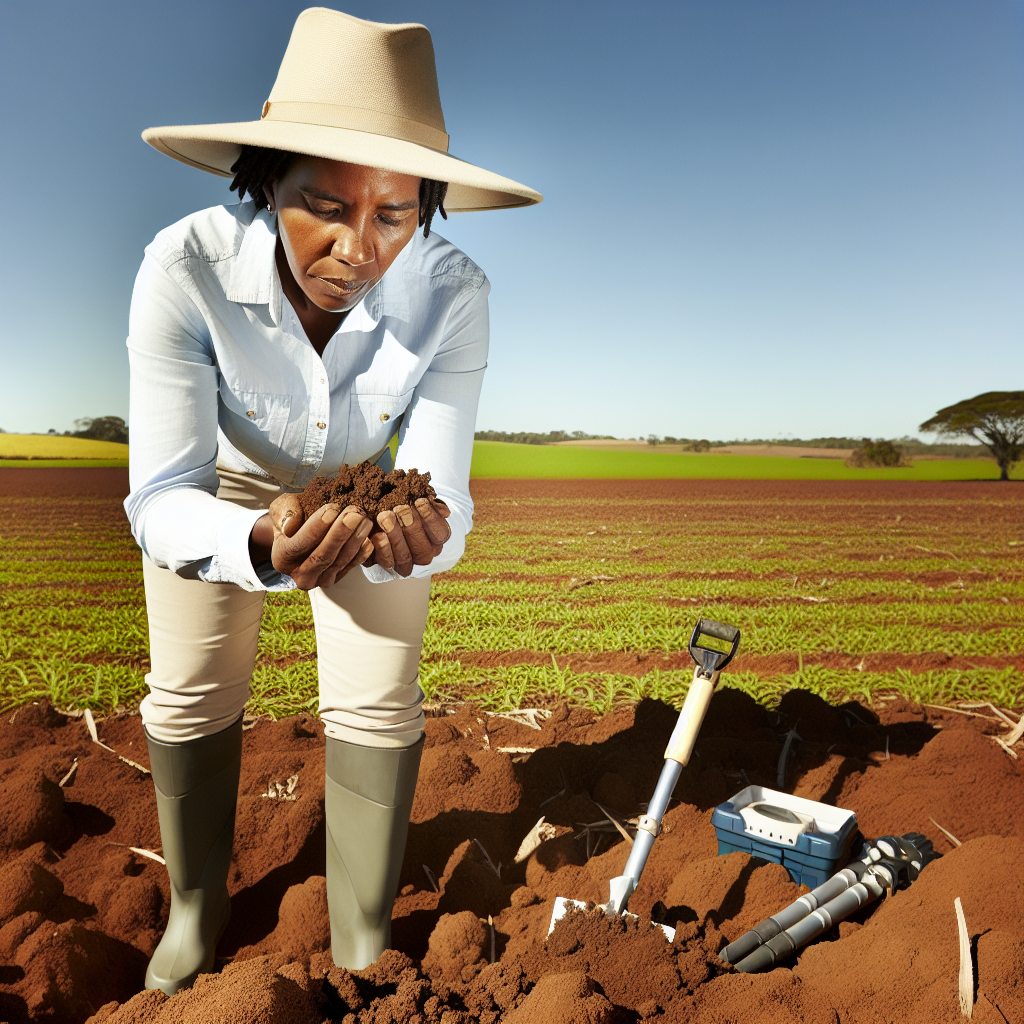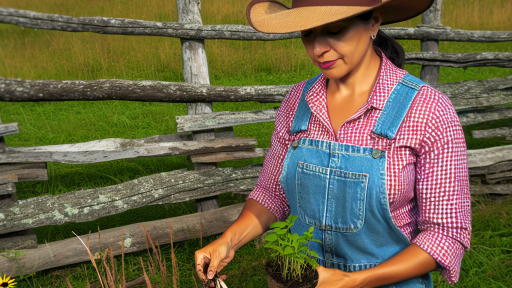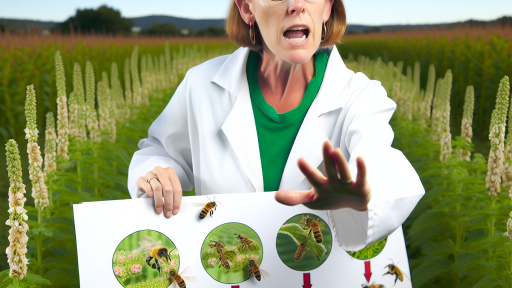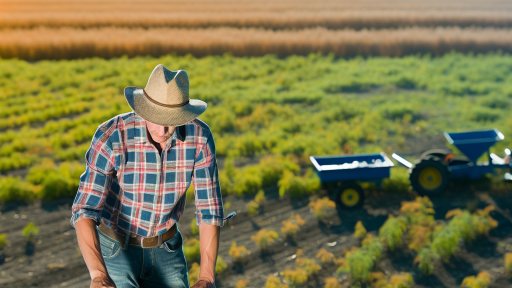Introduction to Soil Health
Importance of Soil Health
Soyl health plays a vital role in ecosystem sustainability.
It affects plant growth and food production directly.
Healthy soil supports diverse organisms and biodiversity.
Moreover, it helps in water filtration and carbon storage.
Maintaining soil health prevents land degradation.
Overview of Soil Health
Soil health refers to the capacity of soil to function effectively.
It encompasses physical, chemical, and biological properties.
Healthy soil promotes robust plant growth and resilience.
It fosters nutrient cycling and water retention.
In addition, it serves as a habitat for soil organisms.
Indicators of Soil Health
Several indicators can assess soil health.
These include soil structure, texture, and organic matter content.
Microbial activity also serves as a significant health indicator.
Regular soil testing can reveal essential nutrient levels.
Benefits of Healthy Soil
Healthy soil enhances agricultural productivity significantly.
Transform Your Agribusiness
Unlock your farm's potential with expert advice tailored to your needs. Get actionable steps that drive real results.
Get StartedIt helps mitigate climate change through carbon sequestration.
In addition, it reduces the need for chemical fertilizers.
Healthy soils improve water quality and conservation efforts.
Thus, prioritizing soil health can lead to long-term sustainability.
Understanding Carbon Sequestration
Definition of Carbon Sequestration
Carbon sequestration refers to the process of capturing and storing atmospheric carbon dioxide.
This technique helps mitigate climate change by reducing greenhouse gases.
Soil plays a vital role in carbon sequestration as a significant carbon sink.
Mechanisms of Carbon Sequestration
Carbon sequestration occurs through several mechanisms in natural systems.
Photosynthesis is the primary process where plants absorb CO2 from the atmosphere.
During photosynthesis, plants convert CO2 into organic matter, storing carbon in their tissues.
When plants die, their biomass decomposes and contributes to soil organic matter.
This process enhances soil health and further stabilizes carbon in the soil.
Role of Soil in Carbon Sequestration
Soil acts as a reservoir for carbon, holding more carbon than the atmosphere and vegetation combined.
The soil’s microbial community plays a crucial role in breaking down organic matter.
Through respiration, microbes release some carbon back into the atmosphere.
However, they also enhance soil structure, improving its ability to store carbon.
Factors Affecting Carbon Sequestration in Soil
Several factors influence the extent of carbon sequestration in soil.
- Soil type affects its capacity to store carbon.
- Land-use practices significantly impact carbon levels.
- Climate conditions determine rates of organic matter decomposition.
Moreover, management practices like cover cropping can enhance sequestration rates.
Importance of Carbon Sequestration
Carbon sequestration plays a pivotal role in combating climate change.
It not only reduces atmospheric CO2 but also enhances soil fertility.
Healthy soils contribute to increased agricultural productivity.
This process supports ecosystem health and biodiversity.
As such, implementing effective carbon sequestration techniques is essential for sustainable land management.
The Role of Soil Microorganisms in Soil Health and Carbon Storage
Understanding Soil Microorganisms
Soyl microorganisms play a crucial role in maintaining soil health.
Showcase Your Farming Business
Publish your professional farming services profile on our blog for a one-time fee of $200 and reach a dedicated audience of farmers and agribusiness owners.
Publish Your ProfileThey include bacteria, fungi, protozoa, and nematodes.
These tiny organisms perform essential functions in the ecosystem.
Key Functions of Soil Microorganisms
Microorganisms decompose organic matter, releasing nutrients into the soil.
They also facilitate nutrient cycling, which benefits plant growth.
Furthermore, they help in the formation of soil structure.
Enhancing Carbon Sequestration
Soyl microorganisms contribute significantly to carbon sequestration.
They convert plant residues into stable organic matter.
This process increases the soil’s carbon storage capacity.
Additionally, they promote the formation of aggregates, which further traps carbon.
Microbial Diversity and Soil Health
Diverse microbial communities enhance soil resiliency.
They can withstand environmental stresses and recover from disturbances.
Moreover, diverse microbes improve nutrient availability and disease suppression.
Applications in Sustainable Agriculture
Farmers can leverage soil microorganisms for sustainable farming practices.
For instance, cover cropping promotes beneficial microbial activity.
Integrating compost and organic amendments enhances soil health.
Additionally, reduced tillage practices support microbial diversity in soil.
Challenges Facing Soil Microorganisms
Soil degradation poses a significant threat to microbial health.
Pollution, monocropping, and excessive pesticide use harm diverse populations.
Therefore, adopting sustainable practices is vital for preserving microbial life.
Uncover the Details: Benefits of Integrated Pest Management in Farming
Conservation Tillage Practices
Introduction to Conservation Tillage
Conservation tillage refers to farming practices that minimize soil disturbance.
This technique enhances soil structure and promotes health over time.
Farmers utilize various forms of conservation tillage globally.
Benefits for Soil Health
Soil health improves significantly with conservation tillage methods.
Firstly, these practices increase organic matter in the soil.
Higher organic matter enhances nutrient availability to crops.
Secondly, reduced soil erosion occurs with less disturbance.
This stability protects soil from degradation during rainfall events.
Additionally, soil moisture retention improves, benefiting crop productivity.
Moreover, microbial activity flourishes in undisturbed soils.
Healthy microbial communities assist in nutrient cycling.
Impact on Carbon Sequestration
Conservation tillage also plays a crucial role in carbon sequestration.
This technique promotes the storage of carbon in the soil.
Increased organic matter contributes to capturing carbon from the atmosphere.
Furthermore, reduced tillage limits the release of carbon dioxide.
Consequently, farmers can help mitigate climate change through these practices.
Types of Conservation Tillage Practices
Various conservation tillage practices exist to suit different farming needs.
- No-till farming leaves the soil largely untouched.
- Reduced tillage involves minimum plowing for seedbed preparation.
- Strip tillage focuses on disturbing only narrow strips of soil.
Each method offers unique advantages while embracing soil health principles.
Challenges and Considerations
While conservation tillage has many benefits, challenges exist.
Farmers may face issues like weed management and soil compaction.
Showcase Your Farming Business
Publish your professional farming services profile on our blog for a one-time fee of $200 and reach a dedicated audience of farmers and agribusiness owners.
Publish Your ProfileEducation and experience play key roles in successful implementation.
Moreover, initial investment in equipment might deter some farmers.
However, the long-term benefits often outweigh these challenges.
Impacts of Conservation Tillage on Future Sustainability
In summary, conservation tillage provides essential benefits for soil health.
It also supports carbon sequestration efforts, contributing to sustainability.
Farmers embracing these practices foster healthier ecosystems for future generations.
Explore Further: Organic Farming and Carbon Sequestration Benefits
Cover Crops: Types, Benefits, and Their Role in Enhancing Soil Carbon
Understanding Cover Crops
Cover crops are plants grown primarily for soil protection and enhancement.
They play a crucial role in sustainable agriculture.
Farmers often use cover crops to improve soil health.
Types of Cover Crops
Diverse types of cover crops exist, each serving unique purposes.
- Legumes, like clover and vetch, enhance nitrogen levels.
- Brassicas, such as radishes and mustards, break up compacted soil.
- Grasses, including rye and oats, protect soil from erosion.
Benefits of Using Cover Crops
Using cover crops offers numerous benefits to farmers and the environment.
- They improve soil structure and fertility.
- Cover crops reduce soil erosion significantly.
- They enhance water retention in the soil.
Moreover, they suppress weeds and pests naturally.
In turn, this leads to reduced reliance on chemical inputs.
Enhancing Soil Carbon through Cover Crops
Cover crops play a significant role in carbon sequestration.
They capture atmospheric carbon dioxide during growth.
This process reduces greenhouse gases in the atmosphere.
Mechanisms of Carbon Sequestration
Cover crops contribute to the formation of soil organic matter.
Root systems from these plants store carbon underground.
As they decompose, they enrich the soil with organic carbon.
Implementing Cover Crops Effectively
Farmers should select appropriate cover crops for their regions.
Timing of planting and termination is critical for success.
Collaborating with agronomists can provide valuable insights.
Regular monitoring can help farmers achieve optimal results.
Gain More Insights: Implementing Recycling Systems on Your Farm
Organic Matter Addition: Composting and its Impact on Soil Health
Importance of Organic Matter
Organic matter enhances soil structure and fertility.
It provides essential nutrients to plants and microorganisms.
Additionally, it improves the soil’s ability to retain moisture.
Benefits of Composting
Composting turns waste into valuable organic matter.
This process reduces landfill waste significantly.
Moreover, composting enriches soil health over time.
Environmental Impact
Composting helps reduce greenhouse gas emissions.
It lowers the production of methane from landfills.
Furthermore, it contributes to carbon sequestration efforts.
Composting Techniques
Various techniques exist for effective composting.
- Hot composting accelerates decomposition through heat.
- Cold composting requires minimal effort and time.
- Tumbler composters facilitate aeration and mixing.
Compost Ingredients
Successful composting relies on a balance of materials.
Carbon-rich materials include dry leaves and straw.
Nitrogen-rich components consist of kitchen scraps and grass clippings.
Monitoring Composting Process
Regular monitoring ensures successful composting.
Check temperature to maintain active decomposition.
Showcase Your Farming Business
Publish your professional farming services profile on our blog for a one-time fee of $200 and reach a dedicated audience of farmers and agribusiness owners.
Publish Your ProfileAerate the pile to promote airflow and reduce odors.
Using Compost in the Garden
Incorporate compost into garden beds for optimal results.
Apply a thin layer of compost around plants as mulch.
This practice helps retain moisture and suppress weeds.
Composting on a Larger Scale
Commercial composting operations enhance soil health broadly.
They convert biosolids and yard waste into useful compost.
Moreover, these operations can provide communities with rich soil amendments.
Case Study: Green Earth Solutions
Green Earth Solutions operates a large-scale composting facility.
This facility turns organic waste into nutrient-rich compost.
Additionally, they provide educational resources to promote composting.
Gain More Insights: Innovative Practices for Carbon Sequestration in Farming

Agroforestry Practices: Combining Trees and Crops for Better Soil and Carbon Benefits
Introduction to Agroforestry
Agroforestry integrates trees with crop and livestock farming.
This practice enhances biodiversity and improves soil health.
Furthermore, it has significant potential for carbon sequestration.
Benefits of Agroforestry
Agroforestry systems provide numerous ecological benefits.
They reduce soil erosion by stabilizing soil with root systems.
Additionally, trees can provide shade, which enhances crop resilience.
Moreover, these practices improve nutrient cycling within the ecosystem.
Carbon Sequestration Potential
Trees absorb carbon dioxide and store carbon in biomass.
This process helps mitigate climate change effects effectively.
Agroforestry can sequester carbon at a large scale over time.
Moreover, it contributes to increasing soil organic matter.
Implementing Agroforestry Practices
Farmers can choose various types of agroforestry systems.
Alley cropping involves planting crops between rows of trees.
Silvopasture combines trees, forage plants, and livestock in one system.
Furthermore, forest farming allows for the cultivation of shade-tolerant crops.
Challenges and Considerations
Despite its benefits, agroforestry presents some challenges.
Farmers may require specialized knowledge for successful implementation.
Additionally, initial investment costs can be a barrier.
However, the long-term benefits often outweigh these challenges.
Enhancing Soil Health and Carbon Benefits
Incorporating agroforestry practices can significantly enhance soil health.
Moreover, they provide substantial carbon sequestration benefits.
Ultimately, these systems support sustainable agricultural practices.
Measuring Soil Health: Tools and Techniques for Assessing Carbon Content
Importance of Soil Carbon Measurement
Understanding soil carbon is vital for maintaining soil health.
Carbon content influences soil structure and fertility.
Moreover, it plays a crucial role in climate change mitigation.
Soil Testing Methods
Various techniques exist to measure soil health effectively.
Traditional soil testing provides baseline data on carbon levels.
This testing often includes assessing pH, nutrients, and organic matter.
Laboratory Analysis
Laboratory analysis offers precise measurements of soil carbon content.
Showcase Your Farming Business
Publish your professional farming services profile on our blog for a one-time fee of $200 and reach a dedicated audience of farmers and agribusiness owners.
Publish Your ProfileSamples are collected and sent to labs for thorough examination.
These labs analyze elements like total organic carbon and inorganic carbon.
Field Methods
Field methods allow immediate assessment of soil properties.
Sensors can gauge soil carbon levels in real time.
Additionally, visual assessments can be combined for a comprehensive approach.
Advanced Techniques
Emerging technologies enhance the measurement of soil health.
Remote sensing offers valuable insights into larger areas.
Moreover, spectroscopy provides quick carbon detection without extensive sampling.
Infrared Spectroscopy
Infrared spectroscopy measures soil properties based on light absorption.
This technique quickly determines organic carbon content.
As a result, it saves both time and resources in analysis.
Soil Moisture Sensors
Soil moisture sensors are essential for understanding carbon dynamics.
They provide real-time data regarding soil moisture levels.
This data correlates closely with soil microbial activity, affecting carbon sequestration.
Integrating Multiple Approaches
Using a combination of methods yields the best results.
Integrating field tests with laboratory analysis enhances accuracy.
Additionally, incorporating advanced technologies strengthens monitoring systems.
Assessment Enhances Soil Health and Carbon Sequestration
Measuring soil health is a multifaceted process.
Employing various tools and techniques ensures comprehensive insights.
Ultimately, better assessment promotes healthier soil and improved carbon sequestration.
Challenges and Barriers to Implementing Carbon Sequestration Techniques in Farming
Economic Constraints
Farmers often face high initial costs when adopting new carbon sequestration techniques.
Furthermore, traditional practices tend to be more familiar and comfortable for them.
Budget constraints can limit their ability to invest in innovative methods.
Consequently, many farmers prioritize short-term profitability over long-term sustainability.
Knowledge and Education Gaps
A lack of awareness about carbon sequestration techniques exists among many farmers.
Many do not receive adequate training on the benefits and implementation of these practices.
Moreover, misinformation about the effectiveness of these techniques can deter adoption.
As a result, extension services often struggle to provide necessary educational support.
Policy and Regulatory Challenges
Current agricultural policies often do not incentivize carbon sequestration practices.
Many regulations can complicate the implementation of new techniques.
Moreover, changes in government can lead to uncertainty regarding ongoing support.
This inconsistency can discourage farmers from adopting carbon sequestration methods.
Soil Management and Environmental Conditions
Soil type and condition significantly influence the success of carbon sequestration methods.
For instance, acidic or degraded soils may not support these techniques effectively.
Additionally, local climate and weather patterns can impact the sustainability of practices.
Farmers often need to customize their approaches based on these environmental factors.
Cultural and Social Factors
Community norms can shape the acceptance of new farming practices.
Some farmers may resist change due to a strong attachment to traditional methods.
Peer influence plays a crucial role in decision-making regarding agricultural practices.
Consequently, successful implementation often relies on community engagement and support.
Showcase Your Farming Business
Publish your professional farming services profile on our blog for a one-time fee of $200 and reach a dedicated audience of farmers and agribusiness owners.
Publish Your ProfileCase Studies: Successful Examples of Soil Health and Carbon Sequestration Practices
Regenerative Agriculture in Iowa
In Iowa, a group of farmers adopted regenerative agriculture techniques.
They focus on minimizing soil disturbance through no-till practices.
Additionally, they implement crop rotation to enhance soil diversity.
This approach promotes organic matter accumulation in the soil.
Resultantly, they observe significant increases in soil health and carbon storage.
Agroforestry in Brazil
In Brazil, several communities practice agroforestry systems.
These systems combine agriculture with tree planting for optimal benefits.
The trees provide shade and support diverse crop growth.
Moreover, their root systems improve soil structure and fertility.
This practice has led to enhanced carbon sequestration and biodiversity.
Cover Cropping in California
California farmers employ cover cropping techniques to boost soil health.
The use of legumes adds nitrogen back into the soil.
Cover crops reduce erosion and increase organic matter levels.
Farmers report higher yields and improved water retention in soils.
Consequently, carbon levels in the soil also show substantial improvement.
Perennial Cropping in Australia
In Australia, researchers have highlighted the benefits of perennial crops.
These crops require less input while improving soil health.
They reduce soil erosion and enhance nutrient cycling naturally.
Farmers find that these practices contribute to increased carbon storage.
This innovative approach promotes sustainability in arid environments.
Integrating Livestock in Crop Production
Many farmers integrate livestock with crop production to enhance soil health.
The animals provide natural fertilizer through manure deposition.
Additionally, they help in controlling weeds and improving soil structure.
Farmers observe increased carbon sequestration rates in these systems.
This strategy effectively utilizes resources and reduces carbon emissions.




